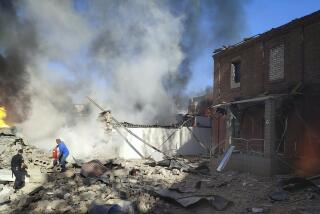Japan nuclear crisis worsens as damage feared to reactor containment vessel
- Share via
An explosion Tuesday at the Unit 2 reactor at a Fukushima power plant may have damaged the reactor’s inner containment vessel, the most serious development yet in the ongoing crisis at the severely damaged facility.
Tokyo Electric Power Co., which owns the Fukushima No. 1 (Daiichi) plant 140 miles north of Tokyo, said radiation levels at the plant were rising and that everyone who lives within 18 miles of the plant had been advised to stay indoors. Nearly 200,000 people who live within 12 miles of the plant had already been evacuated.
A fire has started in a fourth reactor at the site as well, but Japan’s nuclear safety agency quickly report that it had been extinguished.
Photos: Scenes of earthquake destruction
The company has evacuated all personnel from the site except for 50 employees who are attempting to keep the reactor cores cool, a chore that has become increasingly problematic.
There have been at least two interruptions in the efforts to pump seawater into the reactor in the last 24 hours. In the most serious, at least half of the 18-foot length of the fuel rods was exposed to air for more than two hours, long enough for a partial meltdown of the fuel pellets inside the rods.
Company officials have not confirmed whether they have been able to get the fuel rods completely submerged again.
The hydrogen explosion at the Unit 2 reactor was the third explosion in four days at the troubled facility. Previous explosions had destroyed the outer buildings at Units 1 and 3 and damaged the cooling systems for the reactors, but had not damaged the reactor containment vessels, which are designed to hold in the uranium fuel even if it should melt.
The explosion at the Unit 2 reactor just after 6 a.m. Tuesday morning, however, occurred very close to the reactor’s suppression pool. The suppression pool is a donut-shaped unit at the bottom of the reactor that quenches excess steam beyond that needed for the generation of electricity.
There have been reports that the walls of the suppression pool may have been cracked or otherwise breached, which could represent a major escalation of the crisis, said Victor Gilinsky, a former Nuclear Regulatory Commission member who has a doctorate in physics from Caltech.
“If that is true, then there is a path to the control room, the workers and the outside environment,” Gilinsky said.If there has, in fact, been a partial meltdown of the fuel pellets, the uranium would have dripped into the suppression pool, experts said.
In a nationally televised speech, Prime Minister Naoto Kan said the radiation level spreading from the plant “seems very high, and there is still a risk of more radiation coming out.”
Kan said 400 millisieverts of radiation were detected at the plant at about 10:30. That is 20 times the amount a radiation worker may be exposed to annually.
Chief Cabinet Secretary Yukio Edano said, “Now we are talking about levels that can damage human health. These are readings taken near the area where we believe the releases are happening. Far away, the levels should be lower.”
To further complicate the situation, the prevailing winds have shifted and are no longer blowing offshore, but are now wafting the radioactivity in a southerly direction toward Tokyo. The French Embassy said the plume should reach that city in about 10 hours, but unless the radiation release increases substantially, experts believe it will be sufficiently diluted by then to not present a problem.
Photos: Scenes of earthquake destruction
Times staff writer Ralph Vartabedian and Times news services contributed to this report.






